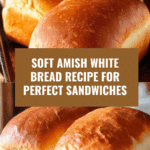Amish White Bread Recipe
This Amish White Bread recipe yields a soft, lightly sweetened white bread with a tender crumb and golden crust. Made with simple pantry ingredients and a classic yeast dough, it can be prepared by hand, with a mixer, or even in a bread machine, making it incredibly versatile. The bread has a delightful homemade flavor and a soft crust that can be enhanced by brushing with butter and covering with a tea towel after baking. Perfect for sandwiches, toast, or simply enjoying with butter and jam.
- Prep Time: 20 minutes
- Cook Time: 30 minutes
- Total Time: 2 hours 30 minutes
- Yield: 2 loaves 1x
- Category: Bread
- Method: Baking
- Cuisine: American
Ingredients
Scale
Liquid Ingredients
- 1 cup water (110°F)
- 1 cup milk (110°F)
- 1/4 cup vegetable oil (melted coconut oil or melted butter works well)
- 2 tablespoons butter (melted, for brushing)
Dry Ingredients and Yeast
- 1 pinch powdered ginger (optional – helps activate yeast)
- 2/3 cup sugar (can use less if desired)
- 1 1/2 tablespoons active dry yeast
- 1 1/2 teaspoons salt
- 5 1/2 cups bread flour (may need a little more or less depending on dough consistency)
Instructions
- Dissolve and activate yeast: In a large bowl, dissolve the sugar in the warm water and milk (both 110°F). Whisk in the active dry yeast and optional powdered ginger. Set aside for 5 to 10 minutes until the yeast mixture becomes foamy, indicating the yeast is active.
- Add initial flour and wet ingredients: Stir in 1 cup of the bread flour. Then whisk in the salt and oil thoroughly to combine with the yeast mixture.
- Add remaining flour and mix dough: With an electric mixer running, add the remaining flour one cup at a time. Continue mixing until the dough pulls away from the sides of the bowl and forms a cohesive mass. Knead with the mixer for about 5 minutes at this stage.
Alternatively, if hand kneading, mix in flour until the dough is sticky, then turn onto a floured surface and knead vigorously for 10 minutes until smooth and elastic, adding flour as needed. - First rise: Oil a large bowl and place the dough ball inside. Lightly oil the top of the dough and cover with a damp cloth. Let the dough rise in a warm place until it doubles in size, which should take about 1 hour.
- Punch down and divide: Once risen, punch the dough down to release air. Knead gently for about 3 minutes. Divide the dough into two equal portions and let them rest for 5 minutes.
- Shape and second rise: Shape each portion into a loaf and place them into greased 9×5-inch loaf pans. Brush the tops with melted butter. Cover and let rise for 30 minutes, or until the loaves have risen about an inch above the pans.
- Bake: Preheat the oven to 350°F. Bake the loaves for 30 minutes or until they sound hollow when tapped. The internal temperature should be 190°F when checked with an instant-read thermometer.
- Optional soft crust finish: To keep the crust soft, brush the tops of the hot loaves with butter right after removing from the oven. Then cover them with a clean tea towel and let cool in the pans for 5 minutes before removing to finish cooling, keeping them covered with the towel.
- Bread machine instructions: Add all ingredients to your bread machine according to the manufacturer’s order, typically liquids first. Select the white bread cycle. Start the machine. When the dough has risen and the second kneading cycle begins, turn the machine off momentarily, then press start again to reset. This allows the dough to rise a second time before the machine bakes the bread.
Notes
- Warm liquid temperatures (around 110°F) are important to activate the yeast without killing it.
- Powdered ginger is optional but encourages faster yeast activation.
- Bread flour is preferred for better gluten development and texture, but all-purpose flour can be used with slightly different results.
- Adjust flour quantity as needed; dough should be soft but not overly sticky.
- Butter or oil can be substituted based on preference or dietary needs.
- For a sweeter bread, increase sugar slightly; decrease for less sweetness.
- Use an instant-read thermometer to ensure perfect baking and avoid underbaked dough.
- Covering baked bread with a tea towel helps keep the crust soft and tender.
- Bread machine users should follow their specific machine instructions for best results.
Keywords: Amish white bread, homemade white bread, easy bread recipe, soft crust bread, bread machine bread, classic white bread
Find it online: https://thedishspot.com/amish-white-bread-recipe/

